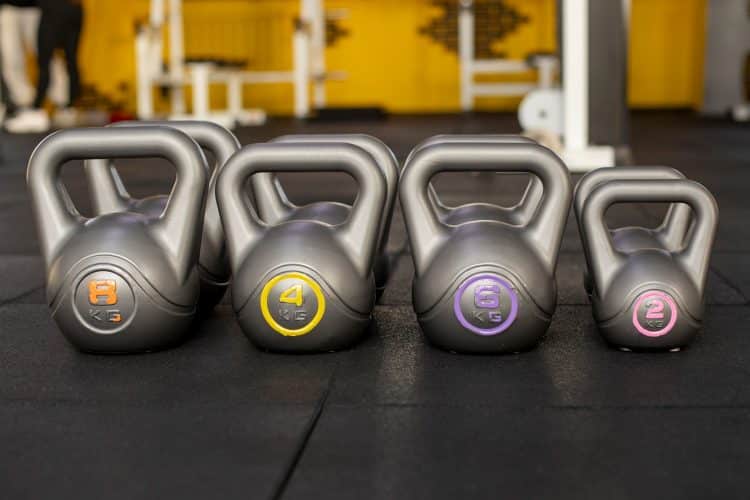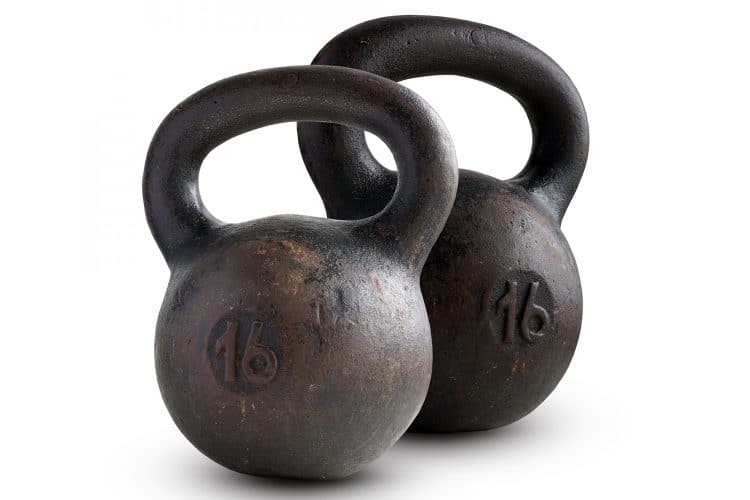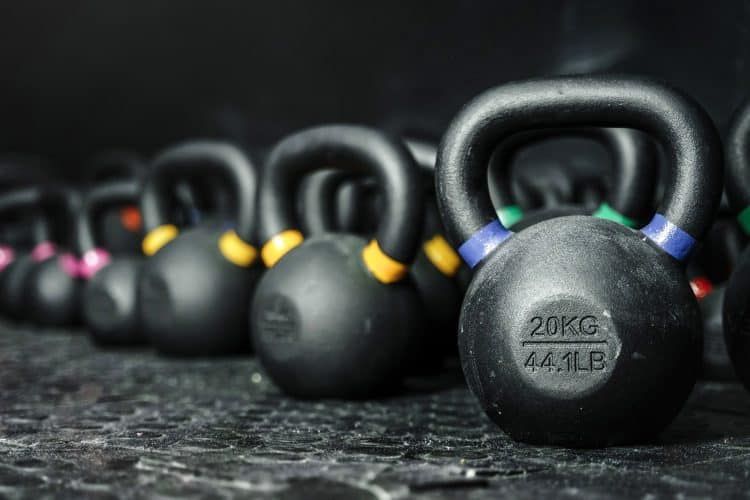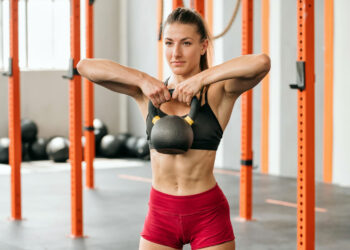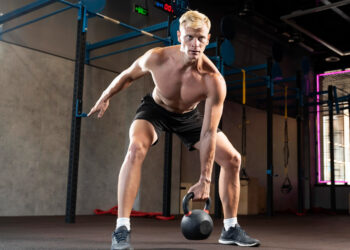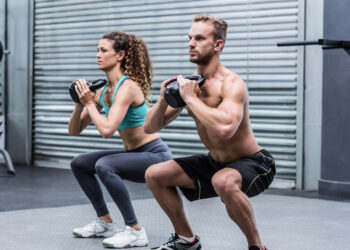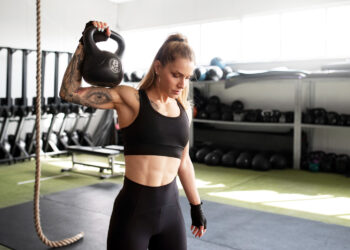Kettlebell weights are, without a doubt, one of the most versatile pieces of exercise equipment.
They can be used for so many exercises—full body ballistic movements like Kettlebell Swings, traditional resistance training options like Curls, even as an unsteady base for more advanced Push-Ups.
Kettlebells can be incorporated into just about any workout, and the fact that they take up less space than dumbbells and barbells often makes them highly practical for an at-home gym.
If you’re thinking about picking up some kettlebell weights, take the time to carefully read over our complete buying guide below. We’ll answer questions like:
- How do I know what size kettlebell weights to buy?
- How many kettlebells do I need?
- What’s the difference between competition and cast-iron kettlebells?
- What should I look for when buying kettlebell weights?
- What are the best kettlebell weights to buy?
By the time you reach the end of this page, you’ll be ready to find the perfect kettlebells to add to your home gym!
How Do I Know What Size Kettlebell Weights to Buy?
Level Up Your Fitness: Join our 💪 strong community in Fitness Volt Newsletter. Get daily inspiration, expert-backed workouts, nutrition tips, the latest in strength sports, and the support you need to reach your goals. Subscribe for free!
This is always a good first place to start!
Kettlebells come in an impressive range of weights—from as small as 2.5 pounds all the way up to 70 or 80 pounds. Many gyms stock the entire range of weights to make sure their resistance trainees have all the equipment they could need for any workout.
But for you, working out at home, you don’t need a massive range of weights. In fact, you can probably get by with a fairly small variety of kettlebells.
For Men:
Men tend to need heavier weights, especially if they’re going to do more ballistic or dynamic workouts. A great range for men would be between 20 pounds and 55 pounds.
20-pound kettlebells are great for one-handed workouts, overhead lifts, and swinging exercises that are better performed with lighter weights. Newbies to kettlebell workouts will find that working with lighter weights is safer, and will reduce the risk of injury.
But having kettlebells up to 55 pounds means you have options if you want to work heavier, or if you plan to do two-handed exercises (such as Kettlebell Swings).
For Women:
The range of weight is just fractionally lighter for women, particularly women who are new to ballistic training or weight loss in general. A great range for women would be between 10 pounds and 35 pounds.
Again, the 10-pound light weights are excellent for simple one-handed movements, while the heavier 35-pound kettlebell can work for two-handed exercises that require more weight.
How Many Kettlebells Do I Need?
This is a bit of an interesting question, and one that is tricky to answer. As with any weightlifting equipment, there is no “one size fits all” solution that works for everyone across the board.
For some people, having a full complement of weights (5-15 different options) allows them more versatility in their workouts, letting them work out with the weight that feels right for each session rather than being limited to what’s available. If you want to invest that much into a full complement of kettlebells and have the space in your home gym, it’s always worth it.
However, for those who just don’t have the space at home to store 20+ kettlebells or who are slowly stocking up their gym, you can get away with anywhere between 3 and 5 pairs of kettlebell weights.
Why do we specify “pairs” of kettlebells rather than just individual kettlebells?
Well, think about how many more options you’ll have for workouts if you have two kettlebells of the same weight rather than just one.
Many exercises call for just one weight (One-Armed Overhead Presses, Turkish Get-Ups, Slingshot, Halo, and countless more), but some are better off when performed with a weight gripped in each hand (Clean and Press, Single Leg Deadlifts, Double Lungs, etc.). If you don’t have pairs of kettlebells, you’ll be limited in what you can do.
Bonus: Buying kettlebells in pairs also ensures you have a backup in case you’re working out with a partner, or if the weights are damaged.
On the flip side, buying just one kettlebell of each weight frees up space for a broader range of weights. Instead of 3 pairs of weights, you can use the same space for six different weights—ensuring you can customize your exercise load.
There are arguments both for buying pairs and singles, but what matters most is the RANGE of weights.
Remember, in the last section, we talked about the ideal weight range (20-55 pounds for men, 10-35 pounds for women).
If you were to buy in pairs, you might end up with just the three most important weight options:
Level Up Your Fitness: Join our 💪 strong community in Fitness Volt Newsletter. Get daily inspiration, expert-backed workouts, nutrition tips, the latest in strength sports, and the support you need to reach your goals. Subscribe for free!
- 20 pounds for lighter exercises
- 35-40 pounds for heavier exercises
- 55 pounds for two-handed movements
For women, that would be:
- 10 pounds for lighter exercises
- 18-25 pounds for heavier one-handed exercises
- 30-35 pounds for two-handed movements
For the average beginner trainee, this is a pretty good range of weight, giving you enough options for just about any workout.
However, if you have more space for storing weights in your home gym, consider adding a few more weights in the middle of those ranges. Smaller weight increments (increasing in 5 pounds rather than 10-15) enable you to transition to heavier weights and gain strength more quickly.
Now that we’ve figured out the weight range, it’s time to get into the kettlebells themselves. We’re going to start with the most important part of the weights: their construction.
Cast Iron vs. Competition Kettlebells
Kettlebells can be made from plastic, vinyl, and other “cheap” materials, but as you can imagine, these tend to be less reliable, more prone to breaking, and overall flawed. Really, the only type of kettlebells worth investing in are made of metal.
There are two basic types of metal kettlebells on the market: cast iron and competition kettlebells.
Both serve a specific purpose and their differing designs make them useful in different situations. Below, we’ll explain what sets them apart and how each can serve you well.
Cast Iron Kettlebells – Cast iron kettlebells are made from a single solid piece of cast iron. The lower cost of the metal means that these kettlebells are cheaper, which makes them an excellent option for people stocking up their home gyms.
There are two pretty important features of cast iron kettlebells:
- Powder-coating. The powder-coating on the handle provides better grip and stops the body of the cast iron kettlebell from rusting.
- Wider handle. The handles are designed to be wider, making them ideal for two-handed exercises.
Cast iron kettlebells tend to be larger, because more metal is needed as the weight increases. This means the larger weights will take up a lot more space than the smaller weights.
Competition Kettlebells – Competition kettlebells are made from steel, with the body typically encased in plastic. But there are a couple of unique and important features:
- Uniform size and shape. The size and shape of the weights remains constant regardless of the weight (denser steel used for heavier weights), making them more compact and easier to store.
- More durable. Steel is much sturdier than cast iron, and the weights have a much longer lifespan than cast iron weights.
Of course, steel-made competition weights are more expensive than cast iron weights. The handle is also a lot smaller—it’s designed for one-handed grip, so they’re not useful for two-handed exercises.
When deciding whether to buy competition or cast iron, the three most important factors to take into account are:
- Versatility. If you need weights that can be utilized for both one- and two-handed movements, consider the wider-grip cast iron kettlebells.
- Cost. Cast iron is cheaper, but steel will last much longer.
- Space. If you’re working in a small room, the uniformly designed steel weights will occupy less space.
What Should I Look For When Buying Kettlebell Weights?
If you’re considering buying kettlebell weights, there are a few factors that you need to take into account:
Handle thickness
If the handle is too thick, you won’t be able to grip it properly. A too-thick handle will negatively impact the quality of your workout. You’ll fight so hard to hold the handle that the exercise will strain your forearms more than whatever other muscle you’re working. It will be nearly impossible to complete proper sets because of the excessive forearm muscle fatigue.
Make sure that the handle is the right thickness for an easy grip. You should be able to wrap your fingers all the way around the handle and hold it comfortably.
Broad, solid base
The base of the kettlebell should be wide enough to provide solid support when you lean on the weight. This makes them suitable for exercises like Kettlebell Push-Ups, which require a sturdy, stable platform that can hold up your body weight without the weight tilting or tipping over.
Note: Some kettlebells come with an incorporated plastic or rubber base attached to the bottom of the weight. This prevents marking on your floors, but it can make the weight more uncomfortable to use for certain exercises and possibly even impede base stability. You’re better off with a kettlebell that has a broad base incorporated into the metal body.
Ovular body
The shape of the body is a minor factor to take into account, but for more advanced trainees, it becomes important. Round-body kettlebells can dig into your forearm when you’re holding the weight racked overhead (such as in the Kettlebell Snatch or Overhead Shoulder Press position). A slightly oval shape will typically be more comfortable in those overhead positions.
Handle width
Remember that cast iron kettlebells have wider handles that are compatible with both one- and two-handed exercises. If you’re shopping for a more versatile weight, you want that wider handle.
Handle coating
More accurately, you want a handle with NO coating. Some kettlebells will use a vinyl or plastic coating (not only for the handle, but also for the weight’s exterior to reduce damage to the floors). Unfortunately, the vinyl or plastic can be damaged during your workout. Damaged handles might actually cut your hand or cause blisters to form, or could cause your grip to slip.
You want either plain steel handles (for competition kettlebells) or powder-coated cast iron. Any other coatings are a no-go!
What Are the Best Kettlebell Weights to Buy?
Ready to start training with your kettlebells? Here are a few of the best options available on the market today:
- CCF K2 Powder Coated Russian Kettlebell – This powder-coated cast iron kettlebell is sturdy, solid, and built with a very stable base. It’s a great beginner kettlebell to add to your home gym.
- Victor Fitness Adjustable Kettlebell – An adjustable kettlebell is a suitable option for those who have very limited space but want the full range of weight options. The included weight discs allow you to raise the weight from 10 all the way up to 40 pounds, with 7 different weight levels.
- Amazon Basics Cast Iron Kettlebell Weight – An economical choice that’s also incredibly durable and with a comfortable, wide-handled grip.
- Kettlebell Kings Competition Kettlebell – This steel-bodied beast is ideal for those who want a competition kettlebell from one of the best-known manufacturers in the country.
Conclusion
Using kettlebell weights can give you an amazingly dynamic, ballistic workout. There are a wide range of weight and design options that make these weights versatile enough for any training session you want. Whatever your fitness goals are, kettlebells are an excellent addition to your home gym. Thanks to the information above, you now know what to look for and how to buy the right kettlebell for your training.

